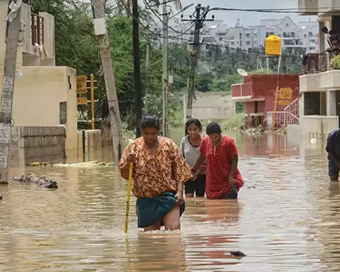 PM Modi visit USA
PM Modi visit USA Only the mirror in my washroom and phone gallery see the crazy me : Sara Khan
Only the mirror in my washroom and phone gallery see the crazy me : Sara Khan Karnataka rain fury: Photos of flooded streets, uprooted trees
Karnataka rain fury: Photos of flooded streets, uprooted trees Cannes 2022: Deepika Padukone stuns at the French Riviera in Sabyasachi outfit
Cannes 2022: Deepika Padukone stuns at the French Riviera in Sabyasachi outfit Ranbir Kapoor And Alia Bhatt's Wedding Pics - Sealed With A Kiss
Ranbir Kapoor And Alia Bhatt's Wedding Pics - Sealed With A Kiss Oscars 2022: Every Academy Award Winner
Oscars 2022: Every Academy Award Winner Shane Warne (1969-2022): Australian cricket legend's life in pictures
Shane Warne (1969-2022): Australian cricket legend's life in pictures Photos: What Russia's invasion of Ukraine looks like on the ground
Photos: What Russia's invasion of Ukraine looks like on the ground Lata Mangeshkar (1929-2022): A pictorial tribute to the 'Nightingale of India'
Lata Mangeshkar (1929-2022): A pictorial tribute to the 'Nightingale of India' PM Modi unveils 216-feet tall Statue of Equality in Hyderabad (PHOTOS)
PM Modi unveils 216-feet tall Statue of Equality in Hyderabad (PHOTOS)Hockey India has announced a 54-member core probable squad for the upcoming senior men’s
- Satwik-Chirag return as BAI names 14-strong squad for BWF Sudirman Cup Finals 2025
- Men’s Sr Hockey Nationals to be played in division-based format from April 4
- Mensik denies Djokovic 100th title in Miami final
- KIPG: Son of a vegetable vendor, Bihar’s Jhandu Kumar eyes Worlds, 2028 Paralympics
- Hardik Singh credits hard work and team unity for receiving HI Midfielder of the Year award
Alert to dangers of high salt intake, many modify diets Last Updated : 01 May 2017 01:41:11 PM IST 
(File Photo)
Indians, aware of the dangers of excessive salt intake, are modifying their diets unlike other international communities like Australians who are sticking to high-salt foods though they are aware of its effects, according to a new study.
Populations in 181 of 187 nations consume more than the WHO-recommended daily upper limit of 5 gm of salt. Indians consume nine per cent more salt than the global average -- 10.06 gm.
Claire Johnson, a research fellow with The George Institute for Global Health, Australia, led an India-centric study on salt intake in February this year. It included a cross-section of 1,395 respondents across India -- educated and uneducated, urban and rural, male and female, and of different ages averaging 40 years.
Nine of 10 respondents said they were aware that a diet high in salt is bad for their health. When asked the question: "How important to you is lowering salt in your diet?" as many answered affirmatively. Not just that, participants actually acted upon this knowledge, lowering their salt intake.
For instance, 98 per cent participants reported using spices other than salt, 61 per cent said they avoided eating out and 52 per cent maintained that they avoided processed foods.
This implies that greater awareness about the health risks of excessive salt intake could benefit Indians significantly because they are open to lifestyle changes.
Every measure to cut down on salt will benefit Indians, said Johnson. "By lowering your salt consumption by 1 gm, you lower your heart attack and stroke risk by 4.8 per cent. And the more you cut down, the more you gain."
One in four Indians living in villages and one in three in its cities suffers from hypertension, or high blood pressure. The control of hypertension requires a reduction in salt intake because too much sodium constricts arteries, thus raising blood pressure, and impairs kidney function, leading to extra fluid and extra strain on the associated blood vessels.
Hypertension is a leading cause of cardiovascular disease. Thus the impact of excessive salt intake on the health of the average Indian is clear: One in four Indians succumbed to cardiovascular disease in 2012.
India's health gains could be "enormous", Johnson told IndiaSpend, if we could cut our average salt/sodium intake by 30 per cent. This would meet one of nine WHO targets to cut premature deaths caused by four major non-communicable diseases. It would also cut the risk of Indians dying by heart attack or stroke by about 15 per cent.
The average Indian consumes 10.98 gm salt a day, according to an earlier Johnson-led study. This is over twice the WHO-recommended upper limit per day, 5 gm, which is just under a teaspoon, and seven times what the body actually needs.
There is a widespread belief in India that in warm weather when the body sweats and loses salt it is imperative to consume more salt. Johnson refutes it. "Irrespective of the weather, physiologically, humans need just one-quarter teaspoon of salt: 1-2 grams which equals 500 mg of sodium daily," said Johnson.
About 10 per cent of the daily salt intake of an Indian occurs naturally in fruit, vegetables, cereal and other raw ingredients, said Johnson. The rest is added during cooking or at the table.
So, cutting down involves adding less salt during cooking and on the table. Both are more doable than making the major dietary changes implicated in controlling salt-intake in the West, where the excess consumption generally comes from salt added to processed foods such as pasta sauces.
India has seen great dietary changes in the last 30 years, noted Johnson. "Indians are eating less pulses, fruits and vegetables and lots more processed and fast foods, and as a result, their diets now include excess salt, sugars and harmful fats," she said. "These are driving up rates of high blood pressure, obesity and cardiovascular diseases, such as heart attack and stroke."
Currently it is impossible to reckon how much salt you are getting from packaged foods in India. Consider:
(a). 1 in 4 products fail to meet the (so far, voluntary) nutrition information labelling guidelines of the Food Safety and Standards Authority of India, and
(b). 2 in 3 products do not list salt on the nutrition information panel and fail International Codex Alimentarius requirements, a collection of standards, guidelines and codes of practice aiming at protecting consumer health and promoting fair practices in the food business.
This may change soon. New Food Safety and Standards Authority of India (FSAI) labelling regulations for all packaged foods are on the anvil.
"Our new guidelines, which should come into effect in a few months, will make it mandatory for packaged food labels to list their salt/sodium (and other nutrients) content, in total and against the recommended daily value," Pawan Kumar Agarwal, CEO of Food Safety and Standards Authority of India, told IndiaSpend.
In the mid-1950s, urban India reported a hypertension prevalence of 1.2 to 4.0 per cent based on the WHO blood pressure diagnosis guidelines then in vogue -- diastolic blood pressure exceeding 95 mmHg, a systolic reading exceeding 160 mmHg.
The prevalence increased to 5 per cent in the 1960s, then to 12 to 15 per cent in the 1990s. Today, about 33 per cent of urban Indians are hypertensive based on revised WHO guidelines-diastolic blood pressure exceeding 90 mmHg, and a systolic reading exceeding 140 mmHg.
Hypertension is a silent killer with few symptoms such as headaches, shortness of breath or nosebleeds, according to Mayo Clinic. In general, hypertension causes so few symptoms that by the time it becomes obvious, the body could have suffered irreparable damage.
Physicians quoted the rule of 50 to explain poor hypertension control, which means: 50 per cent of the hypertensive population is unaware of their condition. Of those who know, only 50 per cent are on appropriate treatment and 50 per cent of those have their hypertension in check.
"Low awareness about hypertension is a bigger problem in rural India than in urban settlements," according to Jugal Kishore, Director, professor and head, Community Medicine at Vardhman Mahavir Medical College, New Delhi, based on the findings of his 2016 study Prevalence of Hypertension and Determination of Its Risk Factors in Rural Delhi.
Cost of treatment is also an issue, said Kishore, as only about 30 per cent Indians avail free health services from the public sector. "Also, the less privileged are intimidated by big hospitals, and the investigations involved in diagnosing a chronic problem, so they tend to ignore symptoms."
Also, blood pressure medication is typically prescribed for a lifetime, which can be hard to accept.IANS For Latest Updates Please-
Join us on
Follow us on








172.31.16.186







